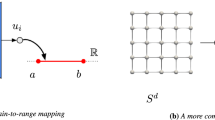Abstract
This paper presents a meshfree collocation method that uses deep learning to determine the basis functions as well as their corresponding weights. This method is shown to be able to approximate elliptic, parabolic, and hyperbolic partial differential equations for both forced and unforced systems, as well as linear and nonlinear partial differential equations. By training a homogeneous network and particular network separately, new forcing functions are able to be approximated quickly without the burden of retraining the full network. The network is demonstrated on several numerical examples including a nonlinear elasticity problem. In addition to providing meshfree approximations to strong form partial differential equations directly, this technique could also provide a foundation for deep learning methods to be used as preconditioners to traditional methods, where the deep learning method will get close to a solution and traditional solvers can finish the solution.





















Similar content being viewed by others
Explore related subjects
Discover the latest articles, news and stories from top researchers in related subjects.Availability of data and material
All data are available upon request and clearance for dispersal.
Code availability
All code is available upon request and clearance for dispersal.
References
Cajori F (1928) The early history of partial differential equations and of partial differentiation and integration. Am Math Month 35:459–467
Grossmann C, Roos H-G, Stynes M (2007) Numerical treatment of partial differential equations. Springer, Berlin
Bathe K-J (2014) Finite element procedures, 2nd edn. K.J. Bathe, Watertown
Cook RD, Malkus DS, Plesha ME, Witt RJ (2001) Concepts and applications of finite element analysis, 4th edn. Wiley, New York
Eymard R, Gallouet T, Herbin R (2000) Finite Volume Methods. In: Techniques of Scientific Computing, Part III, Handbook of Numerical Analysis, VII, North-Holland, pp 713–1020
Gingold R, Monaghan J (1977) Smoother particle hydrodynamics: theory and application to non-spherical stars. Mon Not R Astr Soc 181(375):375–389
Lucy L (1977) A numerical approach to the testing of the fission hypothesis. Aston J 82:1013–1024
Chen JS, Hillman M, Chi SW (2017) Meshfree methods: progress made after 20 Years. J Eng Mech, 143(4):04017001
Cybenko G (1989) Approximations by supersistion of sigmoidal functions. Math Contr Signal Syst 2(4):313–314
Hornik K (1991) Approximation capabilities of multilayer feedforward networks. Neural Netw 4(2):251–257
Park J, Sandberg I (1991) Universal approximation using radial-basis function networks. Neural Comput 3(2):246–257
Lee H, Kang IS (1990) Neural algorithm for solving differential equations. J Comput Phys 91:110–131
Meade A Jr, Fernandez A (1994) The numerical solution of linear ordinary differential equations by feedforward neural networks. Math Comput Modell 19(12):1–25
Lagaris IE, Likas A, Fotiadis DI (1998) Artificial neural networks for solving ordinary and partial differential equations. IEEE Trans Neural Netw 9(5):987–1000
Lagaris I, Likas A, Papageorgiou D (2000) Neural-network methods for boundary value problems with irregular boundaries. IEEE Trans Neural Netw 11(5):1041–1049
Effati S, Pakdaman M (2010) Artificial neural network approach for solving fuzzy differential equations. Inf Sci 180:1434–1457
Kumar M, Yadav N (2011) Multilayer perceptrons and radial basis function neural network methods for the solution of differential equations: a survey. Comput Math Appl 62:3796–3811
Rudd K, Ferrari S (2015) a constrained integration (CINT) approach to solving partial differential equations using artificial neural networks. Neurocomputing 155:277–285
Sirignano J, Spiliopoulos K (2018) DGM: a deep learning algorithm for solving partial differential equations. J Computl Phys 375:1339–1364
Raissi M, Perdikaris P, Karniadakis GE (2018) Numerical gaussian processes for time-dependent and nonlinear partial differential equations. SIAM J Sci Comput 40(1):A172–A198
Raissi M, Karniadakis GE (2018) Hidden physics models: machine learning of nonlinear partial differential equations. J Comput Phys 357:125–141
Raissi M, Perdikaris P, Karniadakis G (2019) Physics-Informed neural networks: a deep learning framework for solving forward and inverse problems involving nonlinear partial differential equations. J Comput Phys 378:686–707
Russell R, Shampine L (1972) A collocation method for boundary value problems. Numer Math 19(1):1–28
Kansa E (1990) Multiquadrics—a scattered data approximation scheme with applications to computation fluid dynamics—I surface approximations and partial derivative estimates. Comput Math Appl 19:127–145
Kansa E (1990) Multiquadrics—a scattered data approximation scheme with applications to computation fluid dynamics—II solutions to parabolic, hyperbolic and elliptic partial differential equations. Comput Math Appl 19:147–161
Tang B (1993) OPrthogonal array-based latin hypercubes. J Am Statist Assoc 88:1392–1397
Goodfellow I, Bengio Y, Courville A (2016) Deep learning. MIT Press, Cambridge
Farlow SJ (1982) Partial differential equations for scientists and engineers. Wiley, New York
Abadi M et al (2015) TensorFlow: Large-Scale Machine Learning on Heterogeneous Systems, Software Available from tensorflow.org
Chollet F (2015) Keras documentation. https://keras.io. Accessed 17 March 2020
Wolfram Research, Inc. (2019) Mathematica, Version 12.0, Champaign: Wolfram Research, Inc.
Belytschko T, Kam Liu W, Moran B (2000) Nonlinear finite elements for continua and structures. Wiley, New York
Acknowledgements
Sandia National Laboratories is a multimission laboratory managed and operated by National Technology & Engineering Solutions of Sandia, LLC, a wholly owned subsidiary of Honeywell International Inc., for the US Department of Energy’s National Nuclear Security Administration under contract DE-NA0003525. This paper describes objective technical results and analysis. Any subjective views or opinions that might be expressed in the paper do not necessarily represent the views of the US Department of Energy or the US Government.
Funding
This work was sponsored by Sandia National Laboratories’ Lab Directed Research and Development (LDRD) 2019 campaign.
Author information
Authors and Affiliations
Corresponding author
Ethics declarations
Conflict of interest
The authors have no conflicts of interest that they are aware of.
Additional information
Publisher's Note
Springer Nature remains neutral with regard to jurisdictional claims in published maps and institutional affiliations.
Rights and permissions
About this article
Cite this article
Brink, A.R., Najera-Flores, D.A. & Martinez, C. The neural network collocation method for solving partial differential equations. Neural Comput & Applic 33, 5591–5608 (2021). https://doi.org/10.1007/s00521-020-05340-5
Received:
Accepted:
Published:
Issue Date:
DOI: https://doi.org/10.1007/s00521-020-05340-5




